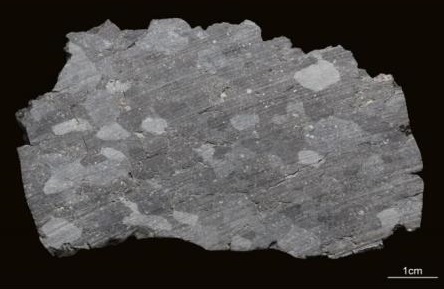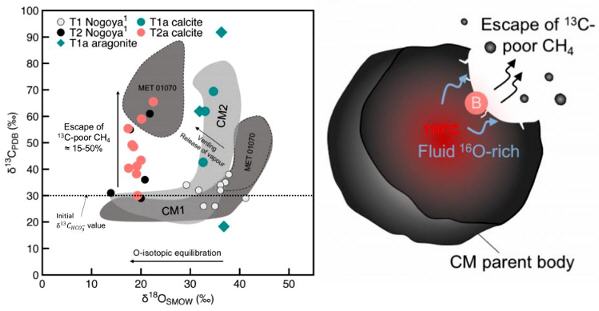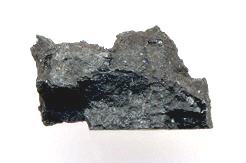Boriskino
CM2, polymict brecciaGeneral term for all breccias that are neither monomict nor dimict. Modified from image source: http://www.saharamet.com/meteorite/gallery/HED/index.html.
Fell April 20, 1930
54° 14′ N., 52° 29′ E. At 1:30 P.M., a carbonaceous chondriteCarbonaceous chondrites represent the most primitive rock samples of our solar system. This rare (less than 5% of all meteorite falls) class of meteorites are a time capsule from the earliest days in the formation of our solar system. They are divided into the following compositional groups that, other than Click on Term to Read More fell in the Federated SSR, USSR. Only two stones with a combined weight of 1,165.6 g were recovered, while three other small stones were reportedly destroyed. Vacher et al. (2018) observed that Boriskino has an unusual brecciated texture consisting of mm- to cm-sized clasts which were subjected to different degrees of alteration (petrologic types 2.1 to 2.6) and experienced diverse shock histories (up to ~30 GPa). They recognized that some clasts exhibit foliation (planar alignment), fractures, flattened chondrulesRoughly spherical aggregate of coarse crystals formed from the rapid cooling and solidification of a melt at ~1400 ° C. Large numbers of chondrules are found in all chondrites except for the CI group of carbonaceous chondrites. Chondrules are typically 0.5-2 mm in diameter and are usually composed of olivine Click on Term to Read More, and other features associated with impact deformation events. 
Image credit: Verdier-Paoletti et al., 80th MetSoc, #6081 (2017) OlivineGroup of silicate minerals, (Mg,Fe)2SiO4, with the compositional endpoints of forsterite (Mg2SiO4) and fayalite (Fe2SiO4). Olivine is commonly found in all chondrites within both the matrix and chondrules, achondrites including most primitive achondrites and some evolved achondrites, in pallasites as large yellow-green crystals (brown when terrestrialized), in the silicate portion Click on Term to Read More and pyroxeneA class of silicate (SiO3) minerals that form a solid solution between iron and magnesium and can contain up to 50% calcium. Pyroxenes are important rock forming minerals and critical to understanding igneous processes. For more detailed information, please read the Pyroxene Group article found in the Meteoritics & Classification category. Click on Term to Read More in Boriskino are essentially Fe-free, occurring as forsteritePure* magnesium end-member (Mg2SiO4) of the olivine solid solution series and an important mineral in meteorites. When magnesium (Mg) is completely substituted by iron, it yields the the pure Fe-olivine end member, fayalite (Fe2SiO4). The various Fe and Mg substitutions between these two end-members are described based on their forsteritic (Fo) Click on Term to Read More and enstatiteA mineral that is composed of Mg-rich pyroxene, MgSiO3. It is the magnesium endmember of the pyroxene silicate mineral series - enstatite (MgSiO3) to ferrosilite (FeSiO3). Click on Term to Read More. According to Ohnishi and Kazushige (2003), enstatite has been aqueously altered to serpentineName used for a large group of phyllosilicate minerals with the generalized formula X2-3 Y2 O5 (OH)4. Due to their various structures (meteoritics focuses primarily on (Fe, Mg)3Si2O5(OH)4), serpentine can be used to understand the chemistry and progress of aqueous alteration (hydration) of olivine, amphibole, or pyroxene dating back to Click on Term to Read More by relatively low-pH fluids enriched in Fe and depleted in Na and Si (smectite is produced at higher pH values and higher Na contents as occurs in the CV group). Iron is present mainly within the serpentine-like phyllosilicatesClass of hydroxyl-bearing silicate minerals with a sheet-like structure. They result from aqueous alteration are dominantly serpentine and smectite in meteorites; found in the matrixes of carbonaceous chondrites. Phyllosilicates consist of repeating sequences of sheets of linked tetrahedra (T) and sheets of linked octahedra (O). The T sheet consists of Click on Term to Read More, with a minor amount present in magnetiteFe oxide, Fe2+Fe3+2O4, containing oxidized iron (Fe3+) found in the matrix of carbonaceous chondrites and as diagnostic component in CK chondrites. In CK chondrites, magnetite is typically chromian, containing several wt. % Cr2O3. Click on Term to Read More. It is thought that magnetite was produced by the oxidationOxidation and reduction together are called redox (reduction and oxidation) and generally characterized by the transfer of electrons between chemical species, like molecules, atoms or ions, where one species undergoes oxidation, a loss of electrons, while another species undergoes reduction, a gain of electrons. This transfer of electrons between reactants Click on Term to Read More of FeS during low-temperature aqueous alteration processes, although some could have a nebular origin (Hyman and Rowe, 1983). Since Boriskino has one of the lowest magnetite contents of any CM chondriteClass of carbonaceous chondrites named after the Mighei meteorite that fell in Ukraine in 1889. They represent samples of incompletely serpentinized primitive asteroids and have experience extremely complex histories. CM meteorites are generally petrologic level type 2 though a few examples of CM1 and CM1/2 also exist. Compared to CI Click on Term to Read More, it probably experienced a relatively moderate degree of parent bodyThe body from which a meteorite or meteoroid was derived prior to its ejection. Some parent bodies were destroyed early in the formation of our Solar System, while others like the asteroid 4-Vesta and Mars are still observable today. Click on Term to Read More alteration.

Diagram credit: Fujiya et al., 47th LPSC, #1712 (2016) O- and C-isotopic values of Type 1 and 2 calcite grains in CM2 Boriskino

Diagram credit: Vacher et al., 81st MetSoc, #6004 (2018) Boriskino contains several FeNi-sulfide/phosphide phases, some of them unknown before. A significant proportion of these phases are P-rich, but they can also contain K and Cr, each of these condensing in a non-typical chalcophile manner. These phases are thought to have formed by the sulfidation of kamaciteMore common than taenite, both taenite and kamacite are Ni-Fe alloys found in iron meteorites. Kamacite, α-(Fe,Ni), contains 4-7.5 wt% Ni, and forms large body-centered cubic crystals that appear like broad bands or beam-like structures on the etched surface of a meteorite; its name is derived from the Greek word Click on Term to Read More in the nebulaAn immense interstellar, diffuse cloud of gas and dust from which a central star and surrounding planets and planetesimals condense and accrete. The properties of nebulae vary enormously and depend on their composition as well as the environment in which they are situated. Emission nebula are powered by young, massive Click on Term to Read More under reducingOxidation and reduction together are called redox (reduction and oxidation) and generally characterized by the transfer of electrons between chemical species, like molecules, atoms or ions, where one species undergoes oxidation, a loss of electrons, while another species undergoes reduction, a gain of electrons. This transfer of electrons between reactants Click on Term to Read More conditions at temperatures below 427°C, or alternatively, during sulfidation of presolar FeNi-carbide grains (Nazarov et al., 1997, 1999). A secondary mineralMineral that forms through processes such as weathering, and in the case of meteorites can also include pre-terrestrial alteration. Secondary minerals in meteorites that formed during terrestrial weathering include oxides and hydroxides formed directly from metallic Fe-Ni by oxidation, phosphates formed by the alteration of schreibersite, and sulfates formed by Click on Term to Read More assemblage consisting of mackinawite (FeS), carbonateMineral or compound containing carbon and oxygen (i.e. calcium carbonate, CaCO3, calcite). Click on Term to Read More, magnetite, and FeNi-metal is associated with low-temperature aqueous alteration processes on the CM parent body (Boctor et al., 2002, 2004). Similar to other CM chondrites, a presolar nanodiamond phase is present in Boriskino that contains the noble gasesElement occurring in the right-most column of the periodic table; also called "inert" gases. In these gases, the outer electron shell is completely filled, making them very unreactive. Click on Term to Read More Xe and Ar, which were implanted at various energies corresponding to different interstellar events. A new noble gasElement occurring in the right-most column of the periodic table; also called "inert" gases. In these gases, the outer electron shell is completely filled, making them very unreactive. Click on Term to Read More component with intermediate characteristics has recently been identified in nanodiamond fractions from Boriskino (Fisenko et al., 2002). Current studies suggest that both cometary dust and meteorites should be produced from the disruption of Jupiter-family comets which originate in the Kuiper beltRegion in the outer solar system beyond Neptune's orbit that contains billions of small, icy planetesimals from the original protoplanetary disc that failed to coalesce into planets. The Kuiper Belt extends from Neptune's orbit at 30 AU to ~55 AU. It is ~20x wider and 20-200x more massive than the Click on Term to Read More. Studies have shown that Antarctic micrometeorites have a similar carbonaceous chondriteChondrites are the most common meteorites accounting for ~84% of falls. Chondrites are comprised mostly of Fe- and Mg-bearing silicate minerals (found in both chondrules and fine grained matrix), reduced Fe/Ni metal (found in various states like large blebs, small grains and/or even chondrule rims), and various refractory inclusions (such Click on Term to Read More:ordinary chondriteWork in Progress Ordinary chondrites (OCs) are the largest meteorite clan, comprising approximately 87% of the global collection and 78% of all falls (Meteoritical Society database 2018)1. Meteorites & the Early Solar System: page 581 section 6.1 OC of type 5 or 6 with an apparent shock stage of S1, Click on Term to Read More ratio (~7:1) as the composition of zodiacal dust (M.M.M. Meier, 2014). Based on observational evidence and current modeling, it is thought that comets should be dark in color and have a low densityMass of an object divided by its volume. Density is a characteristic property of a substance (rock vs. ice, e.g.). Some substances (like gases) are easily compressible and have different densities depending on how much pressure is exerted upon them. The Sun is composed of compressible gases and is much Click on Term to Read More and strength, a high porosityThe volume percentage of a rock that consists of void space. Vesicular porosity is a type of porosity resulting from the presence of vesicles, or gas bubbles, in igneous rock such as the pumice presented here. Vesicular porosity is very rare in meteorites and is often associated with slag, one Click on Term to Read More, a solar ratio of elements, an elevated ratio of C, H, O, and N, a high interstellar grain content, anhydrous and highly unequilibrated silicates, few to no chondrules, and a low cosmic-ray exposure ageTime interval that a meteoroid was an independent body in space. In other words, the time between when a meteoroid was broken off its parent body and its arrival on Earth as a meteorite - also known simply as the "exposure age." It can be estimated from the observed effects Click on Term to Read More (<10 m.y.). Both the CI and CM groups of meteorites exhibit characteristics which are consistent with the above descriptions. Orbital data obtained from several carbonaceous chondrites (e.g., CI OrgueilA large carbonaceous Ivuna-like (CI1) chondrite that disintegrated and fell in fragments near the French town of Orgueil on May 14, 1864. About 20 pieces, totaling ~12 kg in mass, were subsequently recovered from an area of several square km, some head-sized but most were smaller than a fist. Specimens Click on Term to Read More [eyewitness plotting]; CMs Maribo and Sutter’s Mill [instrument recording]) are a good match to the orbits expected from the disruption of Jupiter-family comets, but are unlike the orbits of ordinary chondrites and most other asteroidal objects (M.M.M. Meier, 2014). Both the orbital eccentricityThe deviation of an orbit from circularity. Circles have eccentricities of 0. Click on Term to Read More and semimajor axis for Maribo is nearly identical to those of CometConglomeration of frozen water and gases (methane, ammonia, CO2) and silicates that that formed in the outer solar system and orbits the Sun. In recent years, the description of comets has shifted from dirty snowballs to snowy dirtballs with more dust than ice. However, the ratio is less than 10-to-1. Click on Term to Read More Encke and the associated Taurid swarm of objects (Haack et al., 2011). On the other hand, a CRE age study of CM chondrites conducted by Meier et al. (2016) shows a possible relationship exists to the asteroid breakup event ~8.3 m.y. ago that formed the Ch/C/Cg-type members of the Veritas family. In addition to the large abundance of 3He-enriched interplanetary dust discovered in 8.2 m.y.-old deep-sea drill cores, ~1/6 of all CM meteorites have 21Ne-based CRE ages that are consistent with derivation from this catastrophic breakup, while others with significantly younger CRE ages could represent secondary collisions among the Veritas fragments. The main massLargest fragment of a meteorite, typically at the time of recovery. Meteorites are commonly cut, sliced or sometimes broken thus reducing the size of the main mass and the resulting largest specimen is called the "largest known mass". Click on Term to Read More of Boroskino is curated at the Academy of Sciences in Moscow, while no more than 3.8 g is kept at other institutions (Macke et al., 2011). The photo above shows the interior of a 0.146 g fragment of Boriskino.







